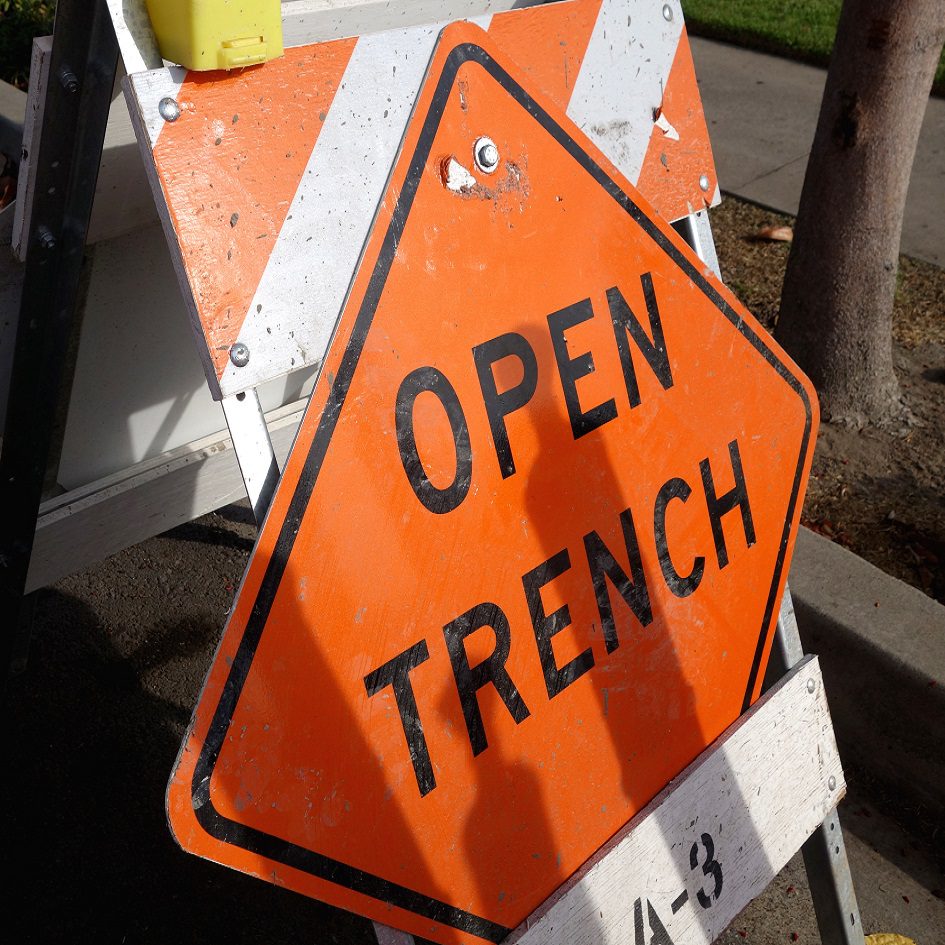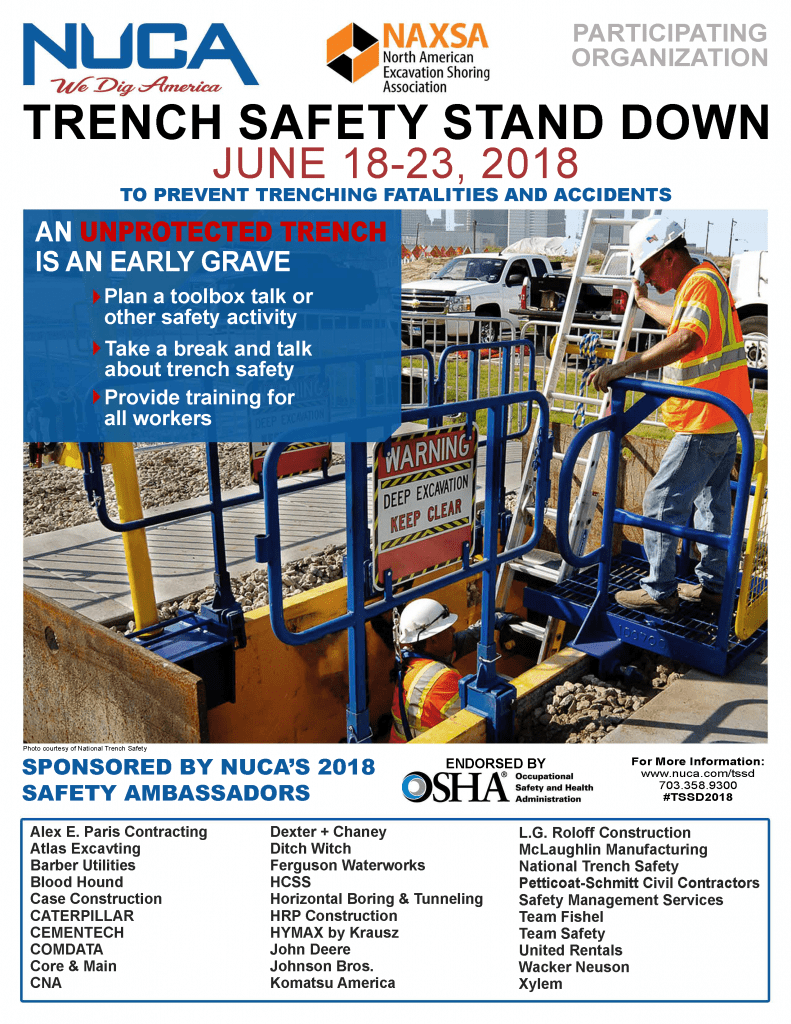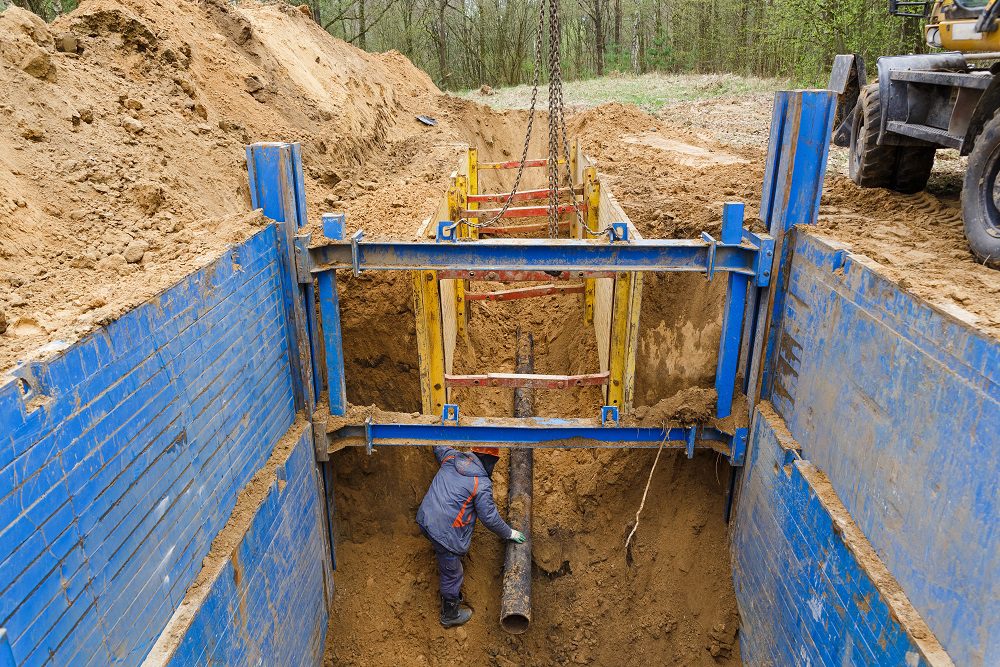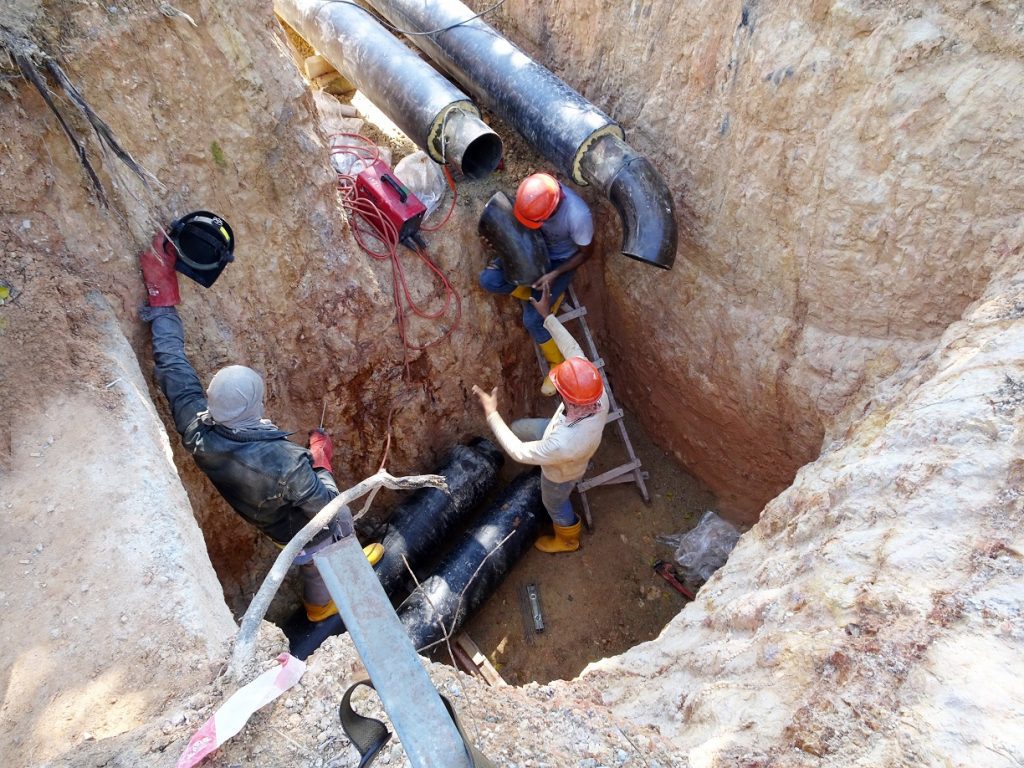
2018 Trench Safety Stand-Down

Written by: Joe Mangiardi, NES, Inc.
 Are there open trenches at your jobsite? It’s time for an open discussion about trench and excavation safety.
Are there open trenches at your jobsite? It’s time for an open discussion about trench and excavation safety.
Trench Safety Stand-Down to Promote Safety
The third annual Trench Safety Stand-Down will be held from June 18 – 23, 2018. The Trench Safety Stand-Down is sponsored by the National Utility Contractors Association (NUCA) and the North American Excavation Shoring Association (NAXSA) and is officially endorsed by the Occupational Safety and Health Administration (OSHA). The goal is simple: to raise awareness about trenching/excavation safety to reduce—and ideally prevent—fatalities and injuries related to trenching and excavation work.
Supporters of the Trench Safety Stand-Down hope to expand awareness by reaching as many workers as possible throughout any and all industries that may benefit from information about the latest excavation requirements and safety procedures. Anyone interested can participate, but NUCA specifically encourages participation by “utility construction, residential, highway construction, plumbers, military, unions, associations, educational institutes, and safety equipment manufacturers” on its Trench Safety Stand-Down webpage. The webpage also mentions that NUCA will provide certificates of participation to those who submit completion forms, and the association will also publish a list of participating organizations’ names on the website.
 Download the 2018 Trench Safety Stand-Down flyer here.
Download the 2018 Trench Safety Stand-Down flyer here.
Employers are encouraged to take this opportunity to hold a “toolbox talk” or other similar activity to speak directly to employees and other affected personnel about safety issues associated with these highly hazardous operations. When doing so, it will be important to identify pertinent hazards and to emphasize the importance of using protective systems developed to safeguard employees who are performing trenching/excavation work.
Various resources to assist in conducting a successful stand-down can be found on NUCA’s Trench Safety Stand-Down webpage including a sign-in sheet, trench safety handout, and trench safety posters (English and Spanish).
Key Topics for a Trench Safety Stand-Down
According to data conveyed by the Safety+Health Magazine articles Trenching and Excavation Safety and Preventing Trench Collapses, 350 workers were killed between 2000 and 2009 as the result of trenching/excavation cave-ins, and there were 23 fatalities and 12 injuries in trench collapses in 2016. These incidents do not always occur in extremely deep trenches; in fact, the National Institute for Occupational Safety and Health (NIOSH) reports that, between 1997 and 2001, 64% of fatalities in trenches occurred at depths of less than 10 feet (NIOSH publication: Preventing Worker Deaths from Trench Cave-Ins).
NIOSH states: “There is no reliable warning when a trench fails. The walls can collapse suddenly, and workers will not have time to move out of the way. Even though small amounts of dirt may not seem treacherous, a single cubic yard of dirt can weigh more than 3,000 pounds, which can fatally crush or suffocate workers.”
A 2004 NIOSH study determined that the absence of a protective system was the number one cause of trench-related fatalities. Before workers can enter a trench, a “competent person” must have designed and installed a protective system. A competent person is someone who:
- Is familiar with soil types and the required protective systems
- Can identify existing and potential hazards
- Is authorized to act in a timely fashion to eliminate any hazardous conditions
There are many factors that can affect soil stability, and these must be understood and taken into consideration when planning and executing a trenching/excavation operation. These factors include soil type, saturation level (water content), any adjacent or nearby past or current trenching/excavation activity, weather and other environmental conditions, presence of heavy equipment or tools, and vibrations caused by machines and motor vehicles.
 Installing metal supports protects trench walls against collapse.
Installing metal supports protects trench walls against collapse.
Before beginning a trenching/excavation project, NIOSH recommends the following:
- A trained competent person must ensure that all safety precautions are implemented prior to workers being allowed on-site
- Call 811 to check for utility lines in the job area, and have any existing lines marked
- Determine safe locations away from the trench area to deposit spoil piles and to designate paths for heavy equipment
- Only workers who are over 18 years of age and who have been properly trained on trenching/excavation hazards and best practices, including knowing never to enter an unprotected trench, are to be allowed on the jobsite; the trench must be immediately exited if anyone suspects a problem with the protective trenching system
- The employer’s emergency action plan must outline protocols to follow in the event of a trench-related incident (for information on emergency action plans, see the NES article Emergency Action Plan Design and Implementation)
 These employees are tempting fate by working at the bottom of this trench without a proper means of egress (among other safety issues).
These employees are tempting fate by working at the bottom of this trench without a proper means of egress (among other safety issues).
There are numerous additional safety considerations for trenching/excavation operations. Some of these include:
- Never work in excavations in which there is accumulated/accumulating water
- No employee is to be permitted underneath loads handled by lifting, digging, or hoisting equipment
- Support systems such as shoring, bracing, or underpinning must be provided where the stability of adjoining buildings, walls, or other structures is endangered by excavation operations
- Sidewalks, pavements, and appurtenant structures must not be undermined unless a support system or another method of protection is provided to protect employees from the possible collapse of such structures
- Ladders are to extend at least 3 feet above the top of the excavation and must be secured
- Employees exposed to public vehicular traffic must be provided with, and must wear, warning vests or other suitable garments marked with or made of retro-reflectorized or high visibility material
- Damaged materials/equipment must be evaluated and approved by a registered professional engineer before being returned to service
- The designated competent person must inspect the excavation area daily
- All wells, pits, shafts, etc., are to be barricaded or covered, and upon completion of operations temporary wells, pits, shafts, etc., must be backfilled
Remember: no economic concerns or time constraints are worth risking worker safety. Beyond the ethical obligation to protect employees, employers are becoming more legally culpable as regulations are refined and penalties are increased. Learn more in the NES article Worker Death from Improperly Fortified Trench Jails Foreman.
Trenching and Excavation Safety Training with NES
While the Trench Safety Stand-Down is officially slated to run from June 18 – 23, 2018, employers should not limit themselves to just one week out of the year. Ensuring that all employees who work in and around these dangerous environments are sufficiently educated on how to stay safe on the job is in everyone’s best interests. NES regularly provides on-site trenching and excavation training to satisfy Title 8 California Code of Regulations Sections 1539, 1540, and 1541 requirements. For more information about trenching and excavation training for your employees, please contact NES at 800-637-2384 / 916-353-2360 or office@nesglobal.net.
References:
NUCA’s Trench Safety Stand-Down Webpage
2018 Trench Safety Stand-Down Completion Form
Safety+Health Magazine Article: Trenching and Excavation Safety
Safety+Health Magazine Article: Preventing Trench Collapses
NIOSH Publication: Preventing Worker Deaths from Trench Cave-Ins (Supersedes 2011-180)
YouTube Video: How Jordan Baughn Was Almost Killed in a 3′ 9″ Deep Trench
